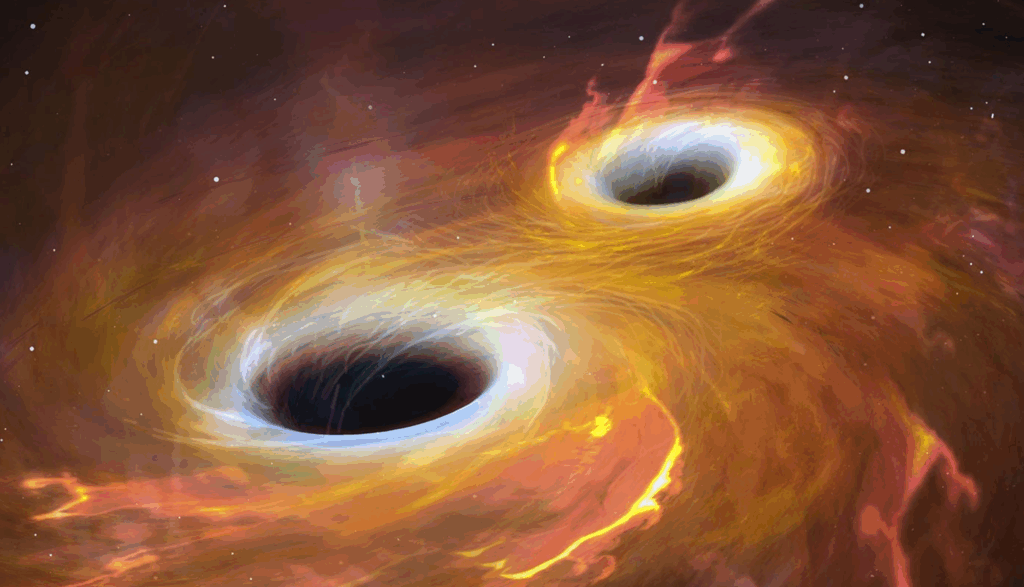
Astronomers have achieved a groundbreaking milestone by capturing the first-ever image of two supermassive black holes orbiting each other within a distant quasar named OJ 287. This historic observation, using the orbiting RadioAstron satellite and radio telescopes on Earth, confirms a theory that had been speculative for decades and opens an unprecedented window into the creation, journey, and eventual collision of black holes.
The discovery comes as a significant confirmation of a 40-year-old prediction, providing insights into the dynamics of black holes and the quasars they power. The image was made possible through a technique known as very long baseline interferometry (VLBI), which combines radio telescopes on Earth to function as one enormous device, enhanced by the orbiting RadioAstron satellite.
The Double Heart Quasar: OJ 287
Located approximately 5 billion light-years away in the constellation Cancer, OJ 287 is a quasar that has intrigued astronomers for decades due to its peculiar, clocklike bursts of light. These bursts, occurring every 12 years, suggested the presence of two black holes: a massive one with a mass over 18 billion Suns and a smaller companion orbiting it.
Whenever the smaller black hole approaches, it plunges through the disk of gas surrounding its partner, causing a sudden flash of light detectable even by amateur astronomers. “The quasar OJ 287 is so bright that it can be detected with a modest telescope,” said Mauri Valtonen of the University of Turku in Finland, who led the research. “What makes it special is that we’ve known for decades it probably hosts two black holes, circling each other every 12 years and producing a recognizable light pattern.”
A Century of Light and a Clue Hidden
The story of OJ 287 dates back to the 19th century when it was inadvertently captured in early sky surveys. At that time, the concept of black holes was unknown. It wasn’t until 1982 that Aimo Sillanpää, a graduate student at the University of Turku, identified the repeating cycle of brightness in the data, proposing that two gravitationally bound black holes were responsible for the pattern. Despite initial skepticism, further data supported his hypothesis, gradually gaining acceptance.
Over the decades, astronomers worldwide observed OJ 287’s light curves, refining models to predict the timing of each flare. However, directly observing both black holes remained elusive until now. The new radio image not only confirms their existence but also provides a detailed view of their dynamics.
Bringing the Invisible into Focus
Traditional optical telescopes, including the Hubble Space Telescope, lack the resolution to distinguish between two black holes a billion light-years away. The VLBI technique, however, allowed astronomers to achieve a resolution 100,000 times greater than conventional optical instruments.
When directed at OJ 287, the combined system observed three radio bright spots: two corresponding to the predicted locations of the black holes and a third, a knot in one of their jets. “They themselves are completely black,” Valtonen explained. “But the jets they produce are cosmic lighthouses. They help us to locate and identify the two objects.”
The Wagging Jet of a Restless Companion
One of the most striking features observed is a corkscrew-like jet of matter erupting from the smaller black hole. Unlike the steady jet of its larger counterpart, this jet “wriggles” due to the smaller black hole’s rapid movement through distorted space, creating a spiral effect.
“This is the first time we’ve actually seen such a jet in a system like this,” Valtonen noted. “It’s an entirely new phenomenon that tells us a lot about how jets respond to motion and gravity.” Researchers anticipate that future observations will reveal changes in the jet’s direction as the smaller black hole alters its velocity and position, offering a direct view of the complex gravitational dance between the two giants.
Decades of Prediction Finally Proven
For over 40 years, astronomers debated whether OJ 287 contained two supermassive black holes. Previous observations, including those by NASA’s TESS satellite, suggested dual light sources but lacked the resolution to confirm them. The new radio map settles this debate.
“The two black holes were exactly where the models had said they would be,” Valtonen stated. “That agreement between theory and observation is extremely reassuring to us about how these systems work.”
This finding validates decades of global scientific effort, proving that binary black holes are not merely theoretical but observable. It provides crucial evidence of galaxy collisions and their evolution over time.
Beyond the Image: What This Means for Science
Capturing an image of two supermassive black holes in orbit is a scientific breakthrough, not a camera trick. Binary black holes are thought to be remnants of colliding galaxies, gradually moving towards each other over millions of years before merging in a burst of gravitational waves. OJ 287 offers a glimpse into this process.
By studying the interaction between the black holes and their jets, astronomers can refine accretion physics models and verify Einstein’s general theory of relativity in extreme conditions. The precise timing of OJ 287’s flares has already been used to test models of gravitational energy loss.
“This is an astronomical lab in which to see gravity at its strongest,” Valtonen remarked. “It’s showing us not just about black holes but about how the universe works.”
Practical Implications of the Research
This imaging success paves the way for studying black hole pairs across the universe. Future telescopes, with even greater precision, can track these systems over millions or billions of years, observing their slow approach and eventual coalescence.
These observations will enable scientists to predict and interpret the gravitational waves produced by such mergers—ripples in spacetime already being detected by LIGO and Virgo. Beyond pure science, this achievement demonstrates human ingenuity and technological capability, revealing the unseen through collaboration and persistence.
For humanity, this accomplishment brings us closer to understanding the formation of galaxies, black holes, and the fundamental role of gravity in the universe. The research findings are published in The Astrophysical Journal.
Related Stories:
- Black hole stars: Giant stars may hide black holes at their core
- A wormhole from another universe? Scientists revisit the puzzling black hole GW190521
- Scientists finally confirm Hawking’s black hole law strengthening Einstein’s theory of gravity
Like these kinds of feel-good stories? Get The Brighter Side of News’ newsletter.







